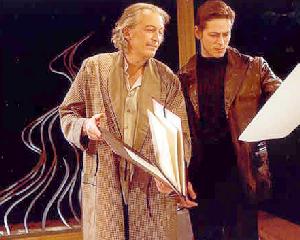SEARCH CurtainUp
REVIEWS
FEATURES
NEWS
Etcetera and
Short Term Listings
LISTINGS
Broadway
Off-Broadway
BOOKS and CDs
OTHER PLACES
Berkshires
London
LA/San Diego
DC
Philadelphia
Elsewhere
QUOTES
On TKTS
LETTERS TO EDITOR
FILM
LINKS
MISCELANEOUS
Free Updates
Masthead
Writing for CurtainUp NYC Weather
The Lonely Way (Der Einsame Weg)
|
We struggle to keep our children from the moment they're born. . .And it's a struggle we're destined to lose. That's the way of the world; our children never really belong to us. As for other people. . .even our best friends are only guests in our lives; they get up from the table when they've finished--and vanish back into their own life.
--- Professor Wegrat, assuring his son that it's all right for him to go off on a distant expedition. Whenever I am absorbed in one of your beautiful creations I invariably seem to find beneath their poetic surface the very suppositions, interests, and conclusions that are also mine. . .I have formed the impression that you know through intuition. . .everything that I have discovered by laborious work on other people. -- Sigmund Freud in a 1922 letter to Schnitzler in honor of the playwright's 60th birthday. |

Ronald Guttman & Eric Alperin
(Photo: Rahav Segev)
|
The waltz music that plays as audiences take their seats in the Mint Theater's fifth floor home reminds us that we're about to re-visit the Vienna of Arthur Schnitzler, the man Sigmund Freud admiringly referred to as his literary doppelganger. The stage is hidden behind scrim thin white canvas curtain framed by a bright red wood proscenium.
When the music stops and the curtain rises on Schnitzler's newly translated, rarely performed The Lonely Way (Der Einsame Weg), we're in for a surprise. That simple proscenium turns out to be a frame to connect the play's outdoor and indoor scenes into a single impressionistic set. No fien de siecle evocation of Schnitzler and Freud's Vienna of Oriental rugs and overstuffed furniture. Instead the gardens and rooms in which a thirty-year love affair and its aftermath evolve are furnished with three molded polymer cubes from architect Frank Gehry's ultra modern indoor-outdoor furniture collection. These set pieces and the staging overall may be off-putting or even distracting to some viewers, but they do make a powerful statement about Schnitzler as a playwright who, contrary to his era, waltzed to a distinctly modern beat.
The Lonely Way's central character, an artist whose midlife career crisis prompts him to redeem his artistic and personal life through the son who has always called another man father, typifies many a commitment phobic modern man. A middle-aged actress he once painted and bedded and who is now haunted by her childlessness, echoes the feelings of many a forty-ish career woman.
For all the typical Schnitzler personae of lovers and mistresses The Lonely Way is essentially an examination of the never dated question as to what constitutes a well-lived life and how well we can really know even the people closest to us. What makes Julian Fichtner (Ronald Guttman), the artist in search of creative and personal redemption, the play's focal character is not that he's the most sympathetic (quite the contrary is true), but that his aborted love affair with Gabriele Wegrat (Sherry Skinker) has had a ripple effect on all the other characters.
Fichtner's grappling with his stalled career and non-relationship with his now 23-year-old son Felix Wegrat (Eric Alperin) coincides with his mother being ill and anxious to do something about a lifetime lived with secrets and lies. Her "confessor" is not her husband, Fichtner's art school classmate who's settled for an academic career (George Morfogen) but Franz Reumann, the family doctor (John Leonard Thompson). The good doctor's love for the Wegrat's daughter Johanna (Constance Tarnoc) is unrequited since she loves Stephan Von Sala (Jordan Lage), a devoted neighbor who is not unlike Fichtner (he's a poet-playwright and also seems to have difficulty with committed relationships). As actress Irene Herms (Lisa Bostnar), is Fichtner's female counterpart, so Dr. Reumann and Professor Wegrat both represent the choice of staying within society's framework, abdicating dreams of freedom and creativity for doing what's right and conventional.
To add yet another melancholy note to the drama, the opening scene between Johanna Wegrat and her brother establishes that she has an extra sense that lets her foresee events before they happen -- especially impending deaths. The scenery may be short of Victorian Vienna accouterments, but there's no shortage of variations on the good life defining theme
A play with so many viewpoints and personal histories to bring to light can be difficult to act. Jonathan Bank's experience in making dramas written long ago stageworthy for the contemporary theater helps his collaboration with translator Margaret Schaefer to keep such difficulties to a minimum. Thus lengthy solo passages that require supporting actors to stand around have been streamlined (though not eliminated). The minimalistic physical production and this new translation thus combine to make a de-fatted but still tasty Viennese strudel. An ever present still life painting of a giant peach is visual shorthand for the artistic careers being examined at the same time that it represents a peach trellis that is referred to but not seen The abstract sculpture inside an upstage frame seems to be a constant reminder of all these characters dreams of moving freely through life. I do think that Mr. Bank has gone overboard in having the program state that the action takes place in present day Vienna -- a conceit that would best be ignored.
The cast has two Mint favorites, Lisa Bostnar and George Morforgen, playing more secondary than usual roles. Bostnar, who's emerged as Mint's leading diva, ignites the stage even though her chances to do so are limited. Morforgen, whom Mint regulars will remember most as the paterfamilias of the Voysey Inheritance (review) plays the soft-spoken Professor Wegrat with admirable understatement.
Ronald Guttman brings the same charming grandiosity to the role of the selfish, philandering Fichtner as he did to the self-absorbed academic Professor Alexander Kaufmann in the Worth Street Theater's modernized Uncle Vanya ( review). Jordan Lage, another newcomer to the Mint whose work I've enjoyed elsewhere (especially at the Atlantic Theater of which he's a co-founder), gives an intriguing portrait as the cynical Stephan Von Sala. The two young people, Johanna and Felix, are ably portrayed by Constance Tarbox and Eric Alpern, with Alpern making a particularly strong impression.
The Lonely Way, like so many vintage treasures given new life at the Mint, proves once again that some of the liveliest and most stimulating plays are to be found near if not quite on Broadway. Dr. Freud might not trade his upholstered consulting couch for Frank Gehry's cubes, but he'd find much to like in this very Freudian staging of his friend Schnitzler's work.
Postcript: The following is an e-mail sent to our Letters page which I thought readers might find interesting.
" After seeing a preview of The Lonely Way I was pleased to note that the New York Times critic liked the play as much as you did. The fact that you and the NYT critic each had your own interpretation of that sculpture seems, to me, to underscore the set design's effectiveness. After thinking about your view of the sculpture as a dancing figure representing dreams of dancing (or living) freely and the NYT view of the sculpture as a twisted road, both these views seem to point to the human yearning to break free from social boundaries. The sculpture's being so open to interpretation also supports Professor Wegrat's statement about the unknown or unknowable factor in even our closest relationships." -- Murray Jackster, Los Angeles.
|
The Lonely Way
Written by Arthur Schnitzler Translated by Margret Scha efer and Jonathan Bank Directed by Jonathan Bank Cast: Eric Alperin (Felix Wegrat), Lisa Bostnar (Irene Herms), Ronald Guttman (Julian Fichtner), Jordan Lage (Stephan Von Sala), George Morfogen (Professor Wegrat), Martin , Bennett Leak (valet to Julian Fichtner), Sherry Skinker (Gabriele Wegrat), Constance Tarbox (Johanna Wegrat), and John Leonard Thompson (Dr. Franz Reumann). Set Design: Vicki R. Davis Costume Design: Henry Schaffer Lighting Design: Ben Stanton Sound Design: Jane Shaw Props: Judy Guralnick Furniture: Frank Gehry Running time: 2 hours plus intermission. The Mint Theater 311 West 43rd Street (5th floor) 212/315-0231, www.minttheater.org. From 2/13/05 to 3/27/05--extended to 5/01/05; opens 2/13/05. Tuesday, Wednesday and Thursday at 7 PM, Friday and Saturday at 8 PM, with matinees Saturday and Sunday at 2 PM. Tickets: $45 Reviewed by Elyse Sommer based on February 10th press preview |

Easy-on-the budget super gift for yourself and your musical loving friends. Tons of gorgeous pictures.

Retold by Tina Packer of Shakespeare & Co.
Click image to buy.
Our Review

At This Theater

Leonard Maltin's 2005 Movie Guide

Ridiculous!The Theatrical Life & Times of Charles Ludlam

6, 500 Comparative Phrases including 800 Shakespearean Metaphors by CurtainUp's editor.
Click image to buy.
Go here for details and larger image.



